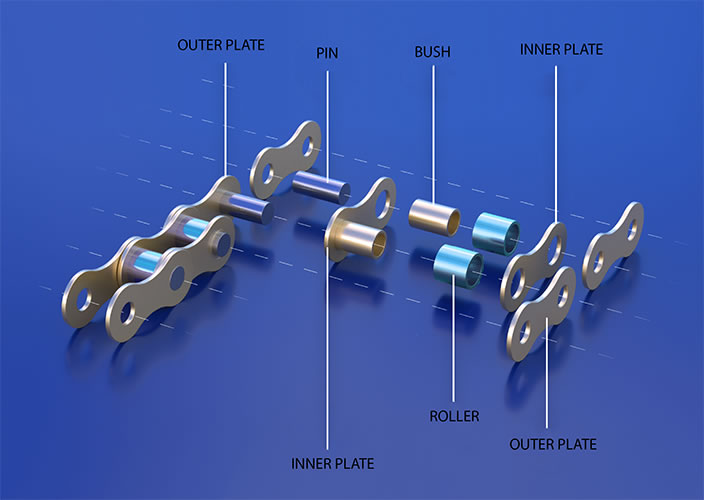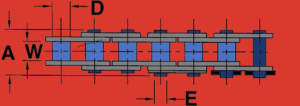


A roller chain is a type of chain drive that connects a toothed wheel (sprocket) to a camshaft, crankshaft, or other rotating machine part. Roller chains are most commonly used in machinery applications including roller chain conveyor industry, wire- and tube-drawing machines, printing presses, cars, motorcycles, and bicycles.
Roller chains consist of links connected to one another by rollers. A roller chain can be thought of as a series of short cylindrical rollers held together by side links. The roller chain is driven by an externally toothed wheel called a sprocket. Roller chains are simple, reliable, and efficient means of power transmission, giving transmission chains their agility and durability. Keep on reading to find out more about roller chains!
What is a roller chain?
Roller chains are also known as bush roller chains, and conveyor roller chains and they are open chains made up of flexible links that are connected by a pin. The bush roller chain is composed of an inner bush (bushing), an outer bush (roller), a pin, and a plate (link) which is shown in the diagram below. A roller chain is ordinarily hooked up using a master link which is called a “connecting link”. Another part which is a half link that is also known as “offset” is used to increase the length of the chain by a single roller.
A roller chain consists of two types of links: regular and offset links. The regular formation of a bush roller chain consists of an inner bush (bushing), an outer bush (roller), a pin, and a plate (link). A roller chain is ordinarily hooked up using a master link which is called a “connecting link”. Another part which is a half link that is also known as “offset” is used to increase the length of the chain by a single roller.
Roller chains also use attachments. The purpose of using roller chain attachments is to offer a wider range of capabilities for your roller chains.
Maintenance and Lubrication of Roller Chains
A roller chain consists of a series of connected traveling metallic bearings which must be properly lubricated to obtain the maximum service life of the chain. Although many slow-speed drives operate successfully with little or no lubrication beyond the initial factory lubrication, proper lubrication will greatly extend the useful life of every chain drive.
Roller chains can be seen in different applications since their original material can be both metal and plastic, depending on what type of application they’re designed to be used. The main difference between roller chains and other kinds of chains is that they are lubricated through the pins and bushings themselves. This will leave you without the need of lubricating it every once in a while. All you need for your systems to have a longer life span is to keep dirt or grime away from it.
Roller chains that are typically made of a metal alloy however have low corrosion resistance and poor wear characteristics. This means that you need to use lubrication methods and substances to have a properly working system. Lubricants can be applied directly to chains, or they can be injected into the spaces between the outside link plate and the inside roller link plate.
What is Chain Roller Used For?
Bicycle chains are a form of roller chain. A bicycle chain may have a master link or may require a chain tool for removal and installation. A similar but larger and thus stronger chain is used on most motorcycles although it is sometimes replaced by either a toothed belt or a shaft drive, which offers lower noise levels and fewer maintenance requirements.
The chain roller is a component of an automobile engine that drives the camshaft. The roller chain is made up of hundreds or thousands of small steel links that are threaded and interlocked to form a continuous loop. The roller chain is driven by a worm or gear, which engages the drive link on rotation. Some automobile engines use roller chains to drive the camshafts. Very high-performance engines often use gear drive, and starting in the early 1960s toothed belts were used by some manufacturers.
Chains are also used in forklifts using hydraulic rams as a pulley to raise and lower the carriage; however, these chains are not considered roller chains but are classified as lift or leaf chains. Chainsaw-cutting chains superficially resemble roller chains but are more closely related to leaf chains. They are driven by projecting the drive chain which also serves to locate the chain onto the bar.
Get in touch with us to discover more usage areas of roller chains at Makelsan and get the service you need in your industry!






Roller chains are a type of chain drive that can be used on almost any vehicle. They work because they have a roller in the center that reduces friction between the chain and the sprockets, resulting in higher efficiency and less wear.
Roller chains use rollers instead of links to connect two sprockets together. This makes these chains more preferable as they can be designed at will to fit almost any type of application. Roller chains also reduce friction compared to simpler designs, resulting in higher efficiency and less wear on your vehicle’s parts.
To identify your roller chain’s size, mark it. Most roller chains have the size stamped right into the side plates. You may see something like “40”, also known as roller chain 40 “C2080H” or “10B” stamped in, which represents the industry number that represents the chain size. Chain sizes can vary from 35 roller chain, roller chain 50, roller chain 60 and to also 06b chain and 08b chain sizes, so you also see the related numbers on the side of the chain. Roller chain suppliers also produce size 60 roller chain and other sizes greater than 60 and they can be found in a broad range of applications, including light- to heavy-duty industrial grade. Old chains will most likely need to be cleaned in order to see this marking. Not every side plate has this marking, therefore you’ll need to clean several side plates before identifying a replacement roller chain.
You can simple measure your chain starting from both ends and divide it by two if you need the numbers for further installment.
Types of roller chains are available in different applications to meet a variety of needs. Roller chain manufacturers produce a wide range of roller chains to satisfy different clients from all sectors.
Standard: The standard roller chain is an economical choice for light loads and applications where the chain will be used in a moderate-duty environment.
Heavy Duty: Heavy-duty roller chains are designed to withstand higher loads than standard roller chains. They have a larger diameter, extra-long links, and thicker plates.
Double Pitch: Double-pitch roller chains are suitable for use with heavy loads or in environments where high wear resistance is required. They have two layers of roller chain links on either side of the main plate to provide higher strength against load stresses.
Hollow Pin: A hollow pin roller chain has a central pin that extends through the entire length of the chain. Hollow pin roller chains can be used with either standard or heavy-duty rolling elements and may also be used with leaf wheels for extra traction when braking.
Leaf: A leaf roller chain has leaf wheels at each end that allow it to turn easily but resist lateral forces from being pressed against an object under load. Leaf chains are most commonly used as part of a rack system with other components such as rollers or pins that allow
Silent Chain: A silent chain is one that is silent when it moves, which can be good for quiet environments.
Plastic Chain: A plastic chain is lightweight. That way, you can easily and confidently use it in areas where you need to limit the weight.
Specialty Chain: Specialty chains are great with other chains that you need to use in your application and also with another type of drive system, like a motor. This will widen your choice of equipment and vehicle as well.


